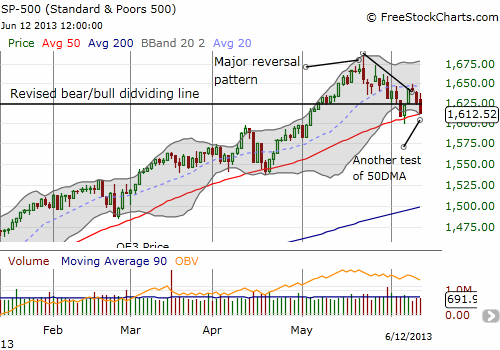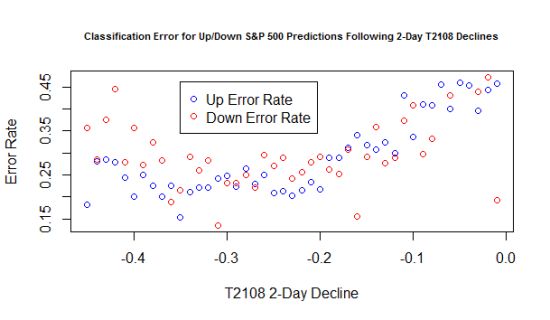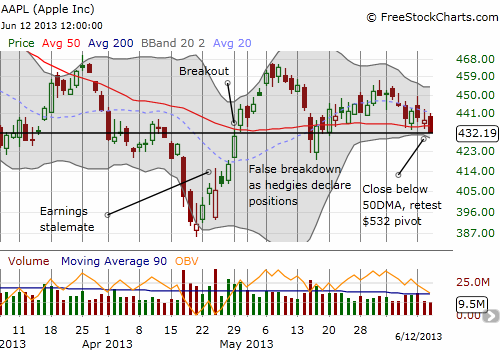(T2108 measures the percentage of stocks trading above their respective 40-day moving averages [DMAs]. It helps to identify extremes in market sentiment that are highly likely to reverse. To learn more about it, see my T2108 Resource Page. You can follow real-time T2108 commentary on twitter using the #T2108 hashtag. T2108-related trades and other trades are posted on twitter using the #120trade hashtag)
T2108 Status: 32.1% (quasi-oversold; lowest point since Nov 20, 2012)
VIX Status: 18.6 (highest close since spike on Feb 25, 2013)
General (Short-term) Trading Call: Go long with tight stops, otherwise play breakdown from 50DMA
Active T2108 periods: Day #2 under 40% (underperiod), Day #15 under 70% (underperiod)
Reference Charts (click for view of last 6 months from Stockcharts.com):
S&P 500 or SPY
SDS (ProShares UltraShort S&P500)
U.S. Dollar Index (volatility index)
VIX (volatility index)
VXX (iPath S&P 500 VIX Short-Term Futures ETN)
EWG (iShares MSCI Germany Index Fund)
CAT (Caterpillar)
Commentary
The S&P 500 is now teetering on a clean breakdown. The setup going into Thursday is almost the exact opposite of what the market faced going into Monday’s trading. Then, I noted there was a good chance of a gap UP. Now, there is a good chance of a gap DOWN.

Supporting a sense of looming danger is the VIX. It closed at its highest point since February 25 when the S&P 500 plunged two days after my first discovery of quasi-oversold conditions. The S&P 500 rallied straight from there after not quite touching the 50DMA. However, this time is “different” because the index already retested the 50DMA just last weekend. As I noted in the last T2108 Update, such a rapid retest strikes me as a demonstration of waning buying power.
I warn of these hints of bearish signals with a sharp tinge of irony. While the T2108 Trading Model (TTM) is predicting a down day for Thursday, I find myself loaded up with call options on Pro Shares Ultra S&P 500 (SSO). How I got into this positioning taught me an interesting lesson in paying attention to the sensitivity of the TTM. The explanation is a bit involved – hang in there with me…
In the last T2108 Update, I noted that I would load up on Pro Shares Ultra S&P 500 (SSO) puts if the T2108 Trading Model (TTM) projected a down day off quasi-oversold conditions, especially with the wedge breaking to the down side. It did not take long to see that today would deliver the second big down day for T2108 to generate quasi-oversold conditions. The 2-day plunge at the close amounted to a whopping 29.1% loss. The intra-day chart makes plain the accelerating downward momentum.

Eager to see what the model predicted, I ran the TTM and tweeted my results. TTM predicted an 83% chance of an up day for Thursday. Given the success of the last time I ran the model early, I set up buy orders for SSO calls. At least I low-balled the bids, recognizing the substantial downside risk remaining in the day as the S&P 500 steadily crept toward its 50DMA. All my orders promptly filled.
As I examined the decision tree associated with the model, it suddenly occurred to me that there were still scenarios where TTM would end up with a prediction of a DOWN day. In particular, if the VIX increased enough with T2108 plunging even more, TTM could predict follow-through selling for the next day. The model for the up prediction relied on the following branches (from bottom to top, skipping info that becomes redundant after knowing the terminal branch, and combining conditions where possible):
A 1-day change for T2108 >= -16.3% and < -8.7%
A VIX change >= +0.5%
A T2108 close >= 18.6 and <= 38.8
There have been 18 occurrences of this scenario since 1990. The model contains 17 different terminal nodes (or scenarios) and only 8 of these predicted up days! In other words, a slight twist in the characteristic of the trading day could generate a different prediction. Sure enough, by the close, the TTM made an 180 degree turn on me by predicting a 75% chance of a DOWN day with a different decision tree. The prediction relied on the following branching (drawn with the same method as above):
A T2108 2-day change >= -31.3%
A T2108 Close < 35.7
A VIX Change >= +5.3%
There have been 8 occurrences of this scenario since 1990. The model contains 12 different terminal nodes (or scenarios) with half of these (6) predicting up days. I thought the relatively low frequency of occurrence provided an example of why the predictions for down days are less reliable than those for up days. However, in this case, the 2-day decline for T2108 produces a nearly equivalent classification error rate for up and down predictions (look up -0.3 on the x-axis and follow the graph upward until hitting the red and blue bubbles at that point).

In other words, I really should have waited until a few minutes before the trading day to make a decision! Note well that this decision to wait will never be easy if the stock market is in the middle of a deep plunge: buying off oversold conditions can happen at any time and without warning. However, in THIS case, there was a reason to wait given my original inclination to go bearish on a break of key support levels. Regardless, I am still grateful for the ability to have this dilemma now that FreeStockCharts.com provides intraday data on T2108.
Here is how I will handle trading for Thursday. If I am lucky enough to get a strong open, I will relieve myself of my SSO calls relatively quickly under the assumption that a fade is coming. If the S&P 500 gaps down, I will just take my lumps and watch for a classic oversold condition (T2108 <= 20%). I consider the prospect of T2108 plunging to oversold conditions to be the small consolation of moving too early on the SSO calls. Oversold conditions could again be pretty powerful. At that point, the S&P 500 will have decisively broken through 50DMA support - encouraging bears to chase the market lower - and the VIX should be much higher - on the edge of overstaying its welcome at whatever lofty level it achieves. I end with this chart of Apple (AAPL). As I tweeted during the day, the stock is NOT looking good and is posied to "easily" retest May lows. It has broken through 50DMA support and closed right on top of the $532 pivot (2012's breakout point). Per the "ATM" (Apple Trading Model), I positioned with puts when AAPL rallied right into 20DMA resistance in order to get a discount on playing a weak close to the week. Note well that 20DMA is STILL trending downward and dominating trade this month even as overall the stock has essentially just churned for a month (or 5 months depending on your perspective!).

Daily T2108 vs the S&P 500

Black line: T2108 (measured on the right); Green line: S&P 500 (for comparative purposes)
Red line: T2108 Overbought (70%); Blue line: T2108 Oversold (20%)
Weekly T2108

*All charts created using freestockcharts.com unless otherwise stated
Related links:
The T2108 Resource Page
Expanded daily chart of T2108 versus the S&P 500
Expanded weekly chart of T2108
Be careful out there!
Full disclosure: long SSO calls; long AAPL shares and put spreads
